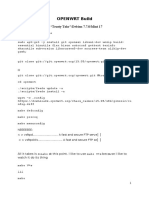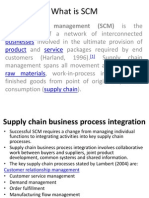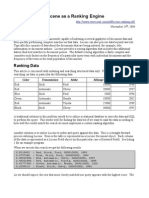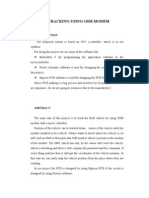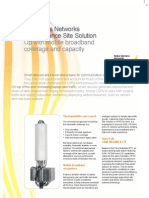Tems Visualization PDF
Tems Visualization PDF
Uploaded by
Wibowo AriCopyright:
Available Formats
Tems Visualization PDF
Tems Visualization PDF
Uploaded by
Wibowo AriOriginal Description:
Original Title
Copyright
Available Formats
Share this document
Did you find this document useful?
Is this content inappropriate?
Copyright:
Available Formats
Tems Visualization PDF
Tems Visualization PDF
Uploaded by
Wibowo AriCopyright:
Available Formats
TEMS VISUALIZATION
BRIDGING THE OPTIMIZATION GAP
TEMS VISUALIZATION 7.1 PROFESSIONAL
SEE YOUR NETWORK IN A WHOLE NEW WAY
TEMS Visualization Professional is
revolutionizing the way network
operators troubleshoot their
networks, enabling them to find
problems that were impossible to
pinpoint before.
TEMS Visualization Professional
provides this ability by analyzing
event-based data generated by the
infrastructure.
The optimization gap
TEMS Visualization Professional processes event-based data, analyzing
and organizing it so that it can be used for network optimization. Operators
have easy access to comprehensive information based on measurement
results and call events, all the way down to the individual call level. This
information can be used for troubleshooting, monitoring, and verifying network functionality.
This ability to look at real individual call data from the infrastructure
side bridges the gap between ordinary Performance Management systems
and traditional drive testing. While Performance Management tools provide
powerful statistical and trending functionality, and drive test tools capture
a specific slice of the network in great detail, TEMS Visualization Professional
gives a closer look at every call from every mobile in the network.
TEMS Visualization Professional is designed to be installed and run on
a single machine. The TEMS Visualization Enterprise solution is also available.
This utilizes dedicated servers for the data processing with many clients
able to connect to the centralized data storage.
Benefits
Trap, track, and eradicate problems based on sequences and specific phone
models.
Understand network problems by viewing the full details of calls made in
the network all calls, all phones.
Drill down into subscriber issues easily using powerful filtering capabilities
and fast browsing functions.
Key features
Processing of event-based data from both WCDMA and GSM networks
Display of full details for all calls on networks with Ericsson infrastructure
Easy optimization of todays very complex networks with built-in
optimization functionality
Direct import of network configuration data from OSS-RC through CNAI
and BulkCM
IRAT Call Tracing using UETR and MTR
Automated task management
TEMS VISUALIZATION 7.1 PROFESSIONAL
Call Event Analyzer
The Call Event Analyzer makes every call within the recorded cell set
available for detailed analysis. It allows the operator to see the major events
associated with a particular call in a history view. Using powerful filtering
and sorting functions, it displays the flow of handovers as either an event
list or plotted on a map. Calls with abnormal events (dropped, blocked,
handover failure, etc.) are easily identified.
TEMS Visualization Professional works with data gathered by the
Ericsson OSSRC. Supported formats are GPEH and UETR for WCDMA networks, and R-PMO, MTR, and CTR for GSM. TEMS Visualization Professional
is compatible with the newest enhancements added on the event side
for both technologies. TEMS Visualization Professional follows calls over
BSC borders, allowing the user to analyze Intra-BSC handovers and follow
all calls made in the recording area. It is now also possible to trace calls
between WCDMA and GSM.
By using TEMS Visualization, operators can do the following, and much
more:
Optimize daily worst cells.
Validate channel allocation (e.g. AMR, overlaid/underlaid optimization).
Filter out calls originating from a selected cell and follow the movement
of each call.
Find the location of dropped calls by following the progression of
serving cells.
Optimize WCDMA neighbor plans.
Identify problems where only one link suffered from poor quality
(uplink and downlink measurement data are available in the tool).
Determine poorly performing mobiles or mobile types.
Analyze problems dependent on response time using the time
difference histogram feature.
In addition, it is easy for the operator to follow the events, radio
environment, and graphical presentation of the serving cell for every call.
This helps operators identify the real reasons for dropped calls, understand
traffic patterns, find missing neighbors, identify ping-pong handover areas,
and perform a host of other optimization activities.
For WCDMA, it is also possible to keep track of the signaling between
the mobile and the core network. Selected information elements are decoded such as the cause value for any location or routing area update reject.
TEMS VISUALIZATION 7.1 PROFESSIONAL
Exception Analysis
The Exception Analysis view gives a summary of all messages and
TEMS Visualization Professional-generated events that occurred during all
the calls in the database. Any exceptional events can quickly be sent to the
Call List for investigation in more detail.
Measurement Result Viewer
The Measurement Result Viewer allows the user to see the common
radio measurements for a call in a set of XY line graphs. All call events
(originations, handovers, drops, terminations) will be shown with vertical
lines upon the XY graphs, with associated event symbols.
Time Difference Histogram
The Time Difference Histogram feature makes it possible to analyze
any problem related to network response time. The user can analyze the
time difference between any two messages or any two events in the database. The results are displayed as cdf and pdf graphs.
Phone List
For WCDMA, statistics are provided per IMSI. This allows individual
customers that are having service problems to be identified. For both GSM
and WCDMA, statistics are provided per IMEI TAC. This allows poorly
performing mobile types to be identified.
The Call Event Analyzer shows detailed call
information.
TEMS VISUALIZATION 7.1 PROFESSIONAL
WCDMA SUPPORT
Radio performance charts
Measurements of signal strength, quality, and power in uplink and
downlink can be displayed in distribution and scatter charts for detailed
investigation of radio performance.
Neighbor Optimization
The Neighbor Optimization feature allows the operator to simultaneously look at missing neighbors as reported by actual users as well as statistics on usage of existing neighbors in order to optimize neighbor relations. This is linked to the map view for easy analysis. Changes can be made
and saved to a BulkCM format file for import into the OSS-RC.
Pilot Pollution Detector
The Pilot Pollution Detector identifies cells suffering from Pilot Pollution.
The operator can then drill down for a detailed analysis of possible polluting
cells. The Pilot Pollution information is displayed as a detailed list, as well as
graphically on the map. Knowing the location and cause of pollution allows
operators to move quickly from identifying the problem to solving it.
Resource monitors
The Resource monitors allow the usage of resources to be analyzed.
Quantities such as power, channel elements, ASEs, and more can be plotted
in time or distribution graphs.
Neighbor Optimization view.
TEMS VISUALIZATION 7.1 PROFESSIONAL
GSM SUPPORT
IRAT Analysis
The IRAT Analysis feature brings together information
from the different GPEH events related to IRAT for further
analysis. Each occurrence of IRAT activity can be followed
all the way from the initial measurements on GSM until its
conclusion.
Cell Timeslot Monitor
The Cell Timeslot Monitor allows the operator to view
all the timeslots of all the channels allocated to a cell/sector
in a pictorial view.
Users can browse through each state (change in the slot
usage for any channel) for the selected cell and monitor
the content of each event; for example, signal strength
of UE.
Each TRU has a frame that will show each timeslot color
coded and by use (AMR, HR, FR, EFR, etc.).
Among many other benefits, this allows the operator to
Dynamically show what actually happened when FR
channels started to load the cell and dynamic HR
adaptation stepped in.
Provide input for multi-band cell optimization
(LOL-TAOL-DTCB-SCLD).
The Cell Timeslot Monitor also includes a load factor,
which makes it easy to identify when the cell had a heavy
load. This is very useful when analyzing the channel allocation algorithms. The Cell Timeslot Monitor also captures
statistics for dropped calls and handover failures on both
the TRU and the timeslot level. This can be used to easily
find hardware that is not working properly.
Estimated positioning
It is possible to display estimated positions of measurement results and TEMS Visualization Professional
events. This information can be used to identify where cells
are covering too far and also gaps in WCDMA coverage
(from positioning of incoming intersystem handover events).
Binned maps
When estimated positions have been calculated, one
or more databases can be loaded into the tool and binned
maps created. These present not predictions but rather the
actual conditions as experienced by the live traffic in the
network. Binned maps can be created for signal strength,
interference, speech quality, traffic density, and TCH dropped
calls. A typical use case would be using the traffic density
maps to determine the advisability of investing in a new
site in areas of poor signal strength.
Faulty equipment analysis
Statistics are given per cell for non-air interface-related
dropped calls (i.e. dropped calls due to transmission problems
can be immediately identified and dispatched to the correct
department). Performance statistics are also given down to
TX and RX level and then graphs of radio performance per TX
or RX can be presented for more detailed analysis.
Tracing module
Tracing for both GSM and WCDMA using MTR and UETR
makes it possible to analyze calls in both WCDMA and GSM
in the same database, a feature unique to TEMS Visualization
Professional. Also, for GSM the CTR format from the OSS-RC
is now supported. Calls passing through a specific cell (up
to 16 at a time) can be recorded and the resulting CTR file
analyzed, making it possible to investigate the performance
for a single cell in great detail.
Task Manager
Handling of OSS data is automated to improve efficiency when working with TEMS Visualization Professional.
Tasks include connection to different OSS or other FTP servers, downloading of OSS data such as recordings and configuration files, parsing of data into databases and cell files,
archiving of old records for ease of use and storage, scheduling of all these tasks to automate the otherwise manual
work, cleanup of old file download history and error messages, and deletion or saving of old data.
TEMS VISUALIZATION 7.1 PROFESSIONAL
Reports
Cell performance reports for both GSM and WCDMA provide a wide
array of useful information, and reports are available for antenna and
speech quality measurements in GSM. Summary reports for both GSM and
WCDMA present key performance indicators for entire databases.
Configuration data handling
Special import features make it possible to create a cell file directly from
an OSS export file. Both CNAI and BulkCM formats are supported. The Import
Wizard also enables filtering and can import multiple files at the same time.
User interface
The user interface in TEMS Visualization Professional is based on the
latest UI features such as auto-hiding of windows. The functionality in the
windows also has the look and feel of the industry-leading air-interface test
tool, TEMS Investigation.
Map views
The map view features call trace functionality. This allows the operator
to view the actual flow of each call, giving a visual representation of how a
particular end-user has been moving in the network.
State engine
TEMS Visualization Professional contains a highly sophisticated state
engine. The unique intelligence the state engine contributes to the tool
provides easier analysis of the most complex problems.
www.ascom.com/networktesting
GSM module
Ericsson GRAN R12-G10A with RTED (Real-Time Event Data) feature
Ericsson OSS-RC with R-PMO feature
WCDMA module
Ericsson WRAN P5-W10A with GPEH feature
Ericsson OSS-RC with GPEH feature
Tracing module
Ericsson WRAN, UETR P5-W10A
Ericsson GRAN, MTR R12-G10A
Ericsson GRAN, CTR 06A-G10A
A revolutionary solution
TEMS Visualization Professional is ideal both for finding network
problems on a cell-by-cell basis and for regional optimization. It also allows
individual areas with poor performance to be identified, even in the midst
of cells where performance is generally very good. TEMS Visualization
Professional gives operators the network information they need.
For more information, visit TEMS on the web at www.ascom.com/
networktesting.
Ascom Network Testing Inc.
1943 Isaac Newton Square
Reston | VA | 20190-5006 | USA
www.ascom.com/networktesting
02.2010 Ascom 2010. All rights reserved. TEMS is a trademark of Ascom. All other trademarks are the property of their respective holders. | 287 01-FAP 901 0970 Uen | Photo: Fotograf Paulina and Fotograf Mijac AB
NETWORK REQUIREMENTS
You might also like
- Process For Nemo Handy and Nemo Analyze To IBwaveDocument7 pagesProcess For Nemo Handy and Nemo Analyze To IBwavecyo3fffNo ratings yet
- DynaTrace5.6 ReleaseNotes XDocument20 pagesDynaTrace5.6 ReleaseNotes XAnonymous 5sWTes100% (1)
- Automating Ip Networks With Python v2Document32 pagesAutomating Ip Networks With Python v2hnt gbfNo ratings yet
- Artifactory-Configuring With JenkinsDocument9 pagesArtifactory-Configuring With Jenkinskhursheed4u3590No ratings yet
- Delphix Admin For Oracle Lab Guide 5.3.5Document61 pagesDelphix Admin For Oracle Lab Guide 5.3.5pap apNo ratings yet
- SrsDocument38 pagesSrsshethNo ratings yet
- GRUB 2 User ManualDocument130 pagesGRUB 2 User Manualbreeeeezzzzze0% (1)
- DrupalDocument9 pagesDrupalComputer Science EducationNo ratings yet
- r007 MTS-5800 GettingStartedGuideDocument178 pagesr007 MTS-5800 GettingStartedGuideNtibileng MoloiNo ratings yet
- SmartOTDR Getting Started Manual - UpdateDocument2 pagesSmartOTDR Getting Started Manual - UpdateZainul ArifinNo ratings yet
- Docker Commands PDFDocument11 pagesDocker Commands PDFghar_dashNo ratings yet
- T o Script SIUDocument26 pagesT o Script SIUDong LedinhNo ratings yet
- Openshift QuestionsDocument4 pagesOpenshift QuestionsAdarsh RajpootNo ratings yet
- Linux NotesDocument17 pagesLinux NotessrinaththiruNo ratings yet
- Multicarrier RBS Configuration and TroubleshootingDocument3 pagesMulticarrier RBS Configuration and Troubleshootingcristachedinu100% (1)
- Appdynamics Database Agent DeploymentDocument14 pagesAppdynamics Database Agent DeploymentmsagaryNo ratings yet
- Grafana InstallDocument5 pagesGrafana InstallraphaelrrlNo ratings yet
- DT-MGW Villa Gtcen1mDocument3 pagesDT-MGW Villa Gtcen1mWillian MilliNo ratings yet
- RedHat Ansible Automation Platform 2.4 - Getting Started With Automation ControllerDocument27 pagesRedHat Ansible Automation Platform 2.4 - Getting Started With Automation ControllerAnalystSENo ratings yet
- GBoverIP - DT For Ericsson BSCDocument51 pagesGBoverIP - DT For Ericsson BSCbharatarora9No ratings yet
- Linux Iw2Document19 pagesLinux Iw2gurureddygNo ratings yet
- h323 Call FlowDocument4 pagesh323 Call Flowchellamanis9953No ratings yet
- Trace RouteDocument3 pagesTrace RouteNarsima ChilkuriNo ratings yet
- Chapter 1 - Introduction To Network Maintenance ObjectivesDocument25 pagesChapter 1 - Introduction To Network Maintenance ObjectivesmeltdownxNo ratings yet
- BSC IP Application Set Up: User GuideDocument40 pagesBSC IP Application Set Up: User GuideSaid IhadadeneNo ratings yet
- Basic Linux ArchitectureDocument11 pagesBasic Linux ArchitectureJyothy LakshuNo ratings yet
- Adding Observability To A Kubernetes Cluster Using Prometheus - by Martin Hodges - Jan, 2024 - MediumDocument2 pagesAdding Observability To A Kubernetes Cluster Using Prometheus - by Martin Hodges - Jan, 2024 - MediumAlain DupresNo ratings yet
- Click TutorialDocument6 pagesClick Tutorialgon1332No ratings yet
- Next-Generation Test Data Management: How To Deliver The Right Test Data, To The Right Teams, at The Right TimeDocument10 pagesNext-Generation Test Data Management: How To Deliver The Right Test Data, To The Right Teams, at The Right Timesaur089229No ratings yet
- Mininet and Openflow LabsDocument14 pagesMininet and Openflow LabsRenuNo ratings yet
- Configure and Verify A Site-To-Site IPsec VPN Using CLIDocument6 pagesConfigure and Verify A Site-To-Site IPsec VPN Using CLIMilošKovačevićNo ratings yet
- AstrixRadioPlanning v1.2 PDFDocument16 pagesAstrixRadioPlanning v1.2 PDFKashifManzoorHussainNo ratings yet
- Bottom of Form C++ Interview Questions and Answers How Can You Tell What Shell You Are Running On UNIX System?Document42 pagesBottom of Form C++ Interview Questions and Answers How Can You Tell What Shell You Are Running On UNIX System?Sriram Madhav NimmagaddaNo ratings yet
- Mad Lab ManualDocument68 pagesMad Lab ManualHonnamma sp4257100% (1)
- Carlosgarcia Slides 180312234839Document96 pagesCarlosgarcia Slides 180312234839parreseNo ratings yet
- Openwrt BuildDocument5 pagesOpenwrt BuildSenchi ZmajNo ratings yet
- Delphix Use CasesDocument12 pagesDelphix Use CasesAlexandre MonteiroNo ratings yet
- STK ACSLS and Veritas NetBackup Media ServerDocument18 pagesSTK ACSLS and Veritas NetBackup Media ServeramsreekuNo ratings yet
- OpenShift Container Platform 3.7 Architecture en USDocument156 pagesOpenShift Container Platform 3.7 Architecture en USVel_stNo ratings yet
- Log StashDocument41 pagesLog Stash98814002aNo ratings yet
- Dra 2Document21 pagesDra 2Achal Kumar100% (7)
- 1.process IntegrationDocument11 pages1.process IntegrationPrem Datt PanditNo ratings yet
- Lucene RankingDocument13 pagesLucene RankingGayane PetrosyanNo ratings yet
- New RelicDocument1 pageNew RelicanthonycacciolaNo ratings yet
- PRO40 Server Monitoring 01july2015Document61 pagesPRO40 Server Monitoring 01july2015samelkaddNo ratings yet
- Appdynamics NodeJS Agent DeploymentDocument13 pagesAppdynamics NodeJS Agent DeploymentmsagaryNo ratings yet
- Zabbix Install ManualDocument6 pagesZabbix Install ManualGohar AhmedNo ratings yet
- 161231132352Document4 pages161231132352Gtulasidhar ReddyNo ratings yet
- NFR - CHECKLIST - ReviewDocument4 pagesNFR - CHECKLIST - ReviewVarun Vikram SinghNo ratings yet
- Sample Java ResumeDocument5 pagesSample Java ResumeChetan100% (1)
- Terraform CommandsDocument5 pagesTerraform CommandsFantahun FkadieNo ratings yet
- Frrouting Developers GuideDocument315 pagesFrrouting Developers GuidevfsrbfhkodzhxinajlNo ratings yet
- Gluster File System 3.2.5 Administration Guide en USDocument98 pagesGluster File System 3.2.5 Administration Guide en USk_abbasNo ratings yet
- Terraform for Developers: Essentials of Infrastructure Automation and ProvisioningFrom EverandTerraform for Developers: Essentials of Infrastructure Automation and ProvisioningNo ratings yet
- Introducing Maven: A Build Tool for Today's Java DevelopersFrom EverandIntroducing Maven: A Build Tool for Today's Java DevelopersNo ratings yet
- Practical Ansible: Learn how to automate infrastructure, manage configuration, and deploy applicationsFrom EverandPractical Ansible: Learn how to automate infrastructure, manage configuration, and deploy applicationsNo ratings yet
- Result Atoll PercobaanDocument3,103 pagesResult Atoll PercobaanWibowo AriNo ratings yet
- Trenggalek Overview May 2015 Rev2-BadspotDocument5 pagesTrenggalek Overview May 2015 Rev2-BadspotWibowo AriNo ratings yet
- Capacity Management Work FlowDocument9 pagesCapacity Management Work FlowWibowo AriNo ratings yet
- How To Install and Use The Arcgis For Autocad Plug-In: 2010 or HigherDocument13 pagesHow To Install and Use The Arcgis For Autocad Plug-In: 2010 or HigherWibowo AriNo ratings yet
- Badspot 2 by Signal Level in Malang (Jln. Sengkaling) : SuramaduDocument2 pagesBadspot 2 by Signal Level in Malang (Jln. Sengkaling) : SuramaduWibowo AriNo ratings yet
- For Vehicle: User ManualDocument23 pagesFor Vehicle: User ManualLuis Alfonso Parra LetterniNo ratings yet
- Cellocator CR200Document2 pagesCellocator CR200Renato BeltránNo ratings yet
- Emtel LTD V The Information and Communication Technologies AuthorityDocument89 pagesEmtel LTD V The Information and Communication Technologies AuthorityDefimediagroup LdmgNo ratings yet
- Jio Company (1) - RemovedDocument53 pagesJio Company (1) - RemovedLucky SrivastavaNo ratings yet
- School Bus TrackingDocument4 pagesSchool Bus Trackingrock starNo ratings yet
- NG911 Standards Identification and AnalysisDocument262 pagesNG911 Standards Identification and AnalysisLexipol_Media_Group100% (1)
- Mobile Assignment IDocument66 pagesMobile Assignment IYogesh Kushwaha100% (4)
- Chapter Five: Public Land Mobile Network (PLMN)Document57 pagesChapter Five: Public Land Mobile Network (PLMN)eyasu abebeNo ratings yet
- 3G Mipt - 08062014Document3,633 pages3G Mipt - 08062014sirnateNo ratings yet
- GSM Capacity Planning-45Document42 pagesGSM Capacity Planning-45abdullaaNo ratings yet
- fmb920 User Manual v0 23 PDFDocument96 pagesfmb920 User Manual v0 23 PDFSile SileNo ratings yet
- Mx382 GSM GPRS PDFDocument2 pagesMx382 GSM GPRS PDFAnonymous swsJWNbCodNo ratings yet
- Decoding GSMDocument217 pagesDecoding GSMmdfirmansyah100% (3)
- A Raja Letter To JPCDocument114 pagesA Raja Letter To JPCNDTVNo ratings yet
- M518 GPS Intelligent Terminal User ManualDocument17 pagesM518 GPS Intelligent Terminal User ManualVinayaga MoorthiNo ratings yet
- SRAN8.0 Multi-Mode BSC Feature Description: Huawei Technologies Co., LTDDocument17 pagesSRAN8.0 Multi-Mode BSC Feature Description: Huawei Technologies Co., LTDSokratesNo ratings yet
- RRU3953&RRU3953w Description: Huawei Technologies Co., LTDDocument25 pagesRRU3953&RRU3953w Description: Huawei Technologies Co., LTDercanaktas100% (6)
- Actix Cellopt AFP User Guide 3 14Document158 pagesActix Cellopt AFP User Guide 3 14Ali Raza SabriNo ratings yet
- Theft Control For The Vehicle Using - GSMDocument4 pagesTheft Control For The Vehicle Using - GSMtukaliNo ratings yet
- Info About Interference Between 850 and 900MHzDocument5 pagesInfo About Interference Between 850 and 900MHzHiew KfNo ratings yet
- Sim7230 Hardware Design v1.02 PDFDocument46 pagesSim7230 Hardware Design v1.02 PDFCristian BandilaNo ratings yet
- LX Manual En-1.6Document63 pagesLX Manual En-1.6Oscar Leonardo Gomez TorresNo ratings yet
- Design and Implementation of A Mobile Application For Logistic Company To Track Parcel MovementDocument25 pagesDesign and Implementation of A Mobile Application For Logistic Company To Track Parcel MovementBashir IdrisNo ratings yet
- Technical Guide For WCDMA LAC Planning (v1.1)Document13 pagesTechnical Guide For WCDMA LAC Planning (v1.1)abuzarshazliNo ratings yet
- WMN Practical No 1 (Roll No. 35, Yash Somani)Document8 pagesWMN Practical No 1 (Roll No. 35, Yash Somani)Hack ManiaNo ratings yet
- HPSS Datasheet 100604 Final PrintDocument2 pagesHPSS Datasheet 100604 Final PrintIdoz SpNo ratings yet
- Telecommunications Infrastructure and Its Impact On Icts in GhanaDocument4 pagesTelecommunications Infrastructure and Its Impact On Icts in GhanaAustine EmegheboNo ratings yet
- Celcom GUL Interworking Strategy - 20161124Document7 pagesCelcom GUL Interworking Strategy - 20161124Muhammad WaqasNo ratings yet
- Accident Detection System Using GPS and GSMDocument15 pagesAccident Detection System Using GPS and GSMPadma Vasavi KNo ratings yet
- Epabx SystemDocument22 pagesEpabx Systemblackjack6161No ratings yet



































